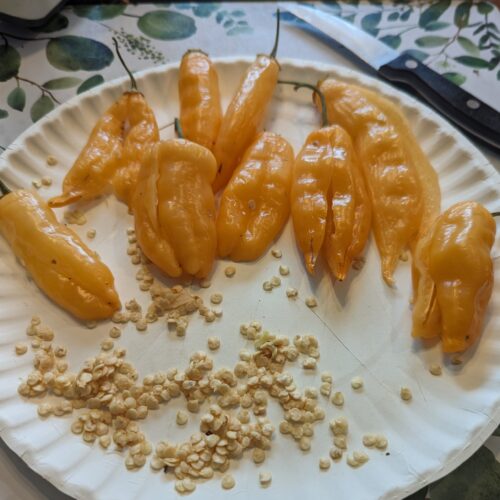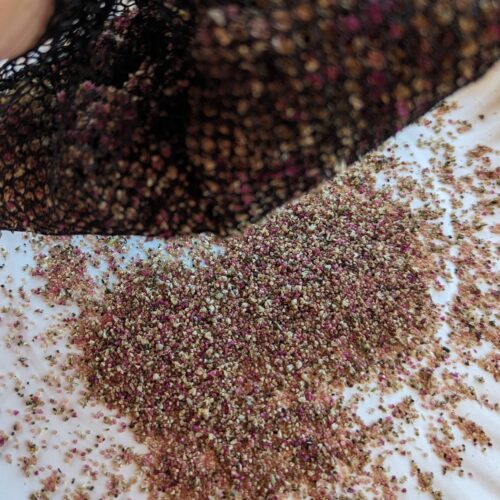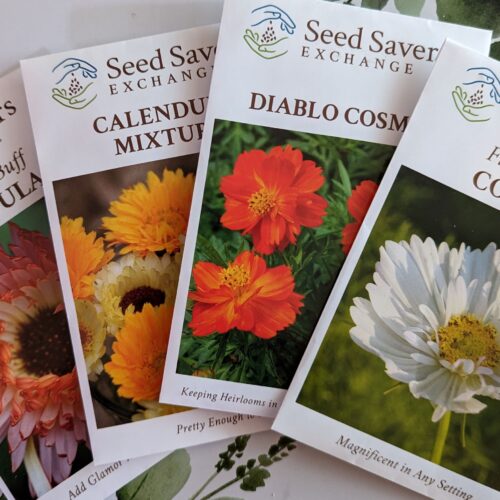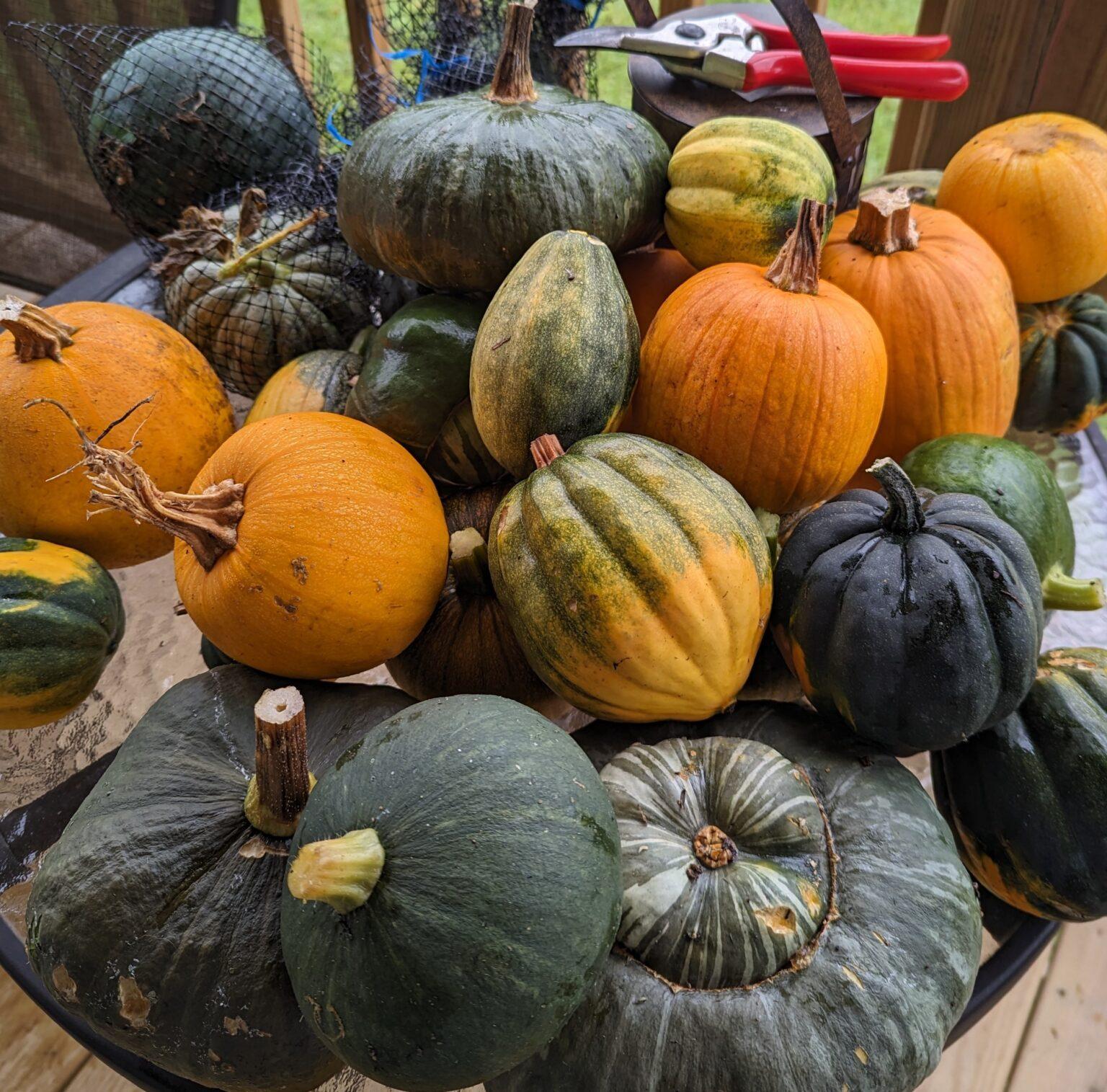If you grow heirloom varieties, you may want to consider seed saving. If you grow hybrid garden varieties, just stop reading now!
Why is that? Many garden plants are hybridized for improvements such as disease (fusarium, verticillium) resistance. If the seed packet indicates “F1”, you are planting a hybrid plant. These hybrids will not produce viable seed or it doesn’t come true from seed, meaning that the qualities selected for don’t carry into the new plant. There are reasons and advantages to grow hybrids, but that is not the subject of this blog post.
This blog is about the heirlooms. But where did the idea of collecting and saving seed come from anyway? Well, plants that have done well in your region, or have the particular qualities you are interested in can be passed along in seed. We recently came across a squash native to the area cultivated by the Cherokee in the 19th Century: Candy Roaster. It is a pink, banana-shaped squash with a blue tip. It is an heirloom cultivated in the mountains of western North Carolina, northern Georgia and eastern Tennessee. A definite keeper!
Here’s a selection of heirlooms that you might easily save seed from:
- Pumpkins
- Cinderella pumpkin
- Connecticut field pumpkin
- Musquee de Provence
- Lady Godiva
- Winter Squash
- Peanut Squash
- Red Kuri
- Blue Hubbard
- Acorn
- Butternut
- Candy Roaster
- Beans
- Scarlet runner
- Yardlong
- Roma
- Anellino di Trento
- Tomatoes
- Cherokee Purple
- Indigo Blue Chocolate
- Black Strawberry
- Peppers
- Sugar Rush Peach
- Purple UFO
- Purple jalapeno
- Red pepperoncini
- The Flower Bed
- Cleome
- Sunflower
- Love-lies-bleeding
- Coreopsis
- Calendula
- Tansy
Notes on Saving Seed
One of the things to keep in mind when planting your garden for seed saving is that plants will cross pollinate. If you plant peppers too close together for example, you may get a varietal cross. Grow peppers sufficiently apart from each other or net them to avoid cross pollination.
Excise the seed from the fruit and allow them to air dry. Once dry, store pepper seeds in a cool, dark space from 35 to 50F. A refrigerator is a good place to store seed. Place the seed in a zip lock bag or in aluminum foil and label and date the varietal.

Save tomato seeds in the same way. Storing seed in a cool, dark (and dry!) place ensures its viability. Seed will lose viability over time reflected in reduced rate of germination.
For pumpkins and winter squash, remove the seed from the fruit, and wash off the placenta (the stringy material). Spread the seeds out on a paper plate and allow to air dry for 7 days. Once dried, store in an envelope or paper bag marked with the varietal and year.

Sunflowers: hold the seed head over a clean bucket and remove the seed with your hand. Spread the seed on newspaper and allow the seed to dry thoroughly; about a week should do it. Store in paper bags marked with varietal and year. Use an indelible pen (e.g., Sharpie) to mark your seed storage bags. Store in a cool dry place. A plastic storage container works fine.

Cleome (Spider flower) is in its own family (Cleomaceae), but is closely related to the mustards (Brassicaceae). The flowers are indeterminate, meaning that it continually flowers and sets seed as it grows. The implication is that the most mature seed is lowest on the plants stem. The seeds reside in a pod, akin to the mustards, and when mature dehisces (burst open). In fact, the plant easily self-sows. But if you want to propagate the plant to new beds, a good strategy is to collect seed. Store in a cool, dark, dry place in a plastic container. The container will help protect the seed from rogue mice and other critters!

Saving Amaranthus caudatus (Love-lies-bleeding) seed: many parts of this plant are edible including the leaves and seed. The plant produces a profusion of pendant red flowers throughout the summer. Each panicle produces seed within dry fluff, each less than 1 mm in size. The seed can be separated from the dry fruit using a mesh bag. Just shake over a paper plate to collect the seed.


The Composites: this group contains marigolds, calendula, cosmos, coreopsis and tansy, among others. The group forms a flower head which is comprised of many florets in what we perceive as a single flower. They are often of two types: disc and rays. The rays are straplike in form and usually make up the perimeter of the floral head. Tansy (Tanacetum vulgare) forms composite head of only disc flowers, lacking rays altogether. When the flower heads fade and brown, the seed is mature. Some species shatter easily, but plants like tansy and marigold seed are retained well in the head.
Beans: collect the seed when the pods ripen turning brown. Allow to seed to air dry, and store in a cool, dark and dry place.


One of the most fascinating aspect of seed is that it is an alternate form of the plants’ life. Once collected and dried, it appears inert and lifeless. However, within the seed, there is enough energy storage (in the form of starches and oils) and information (in the form of DNA) for future growth. It will remain in a dormant state until days lengthen, temperatures warm and the rains come. Truly an amazing adaptation!
Join us next time when we get a little more into the holiday spirit.
~ Signing off for now, Joe

